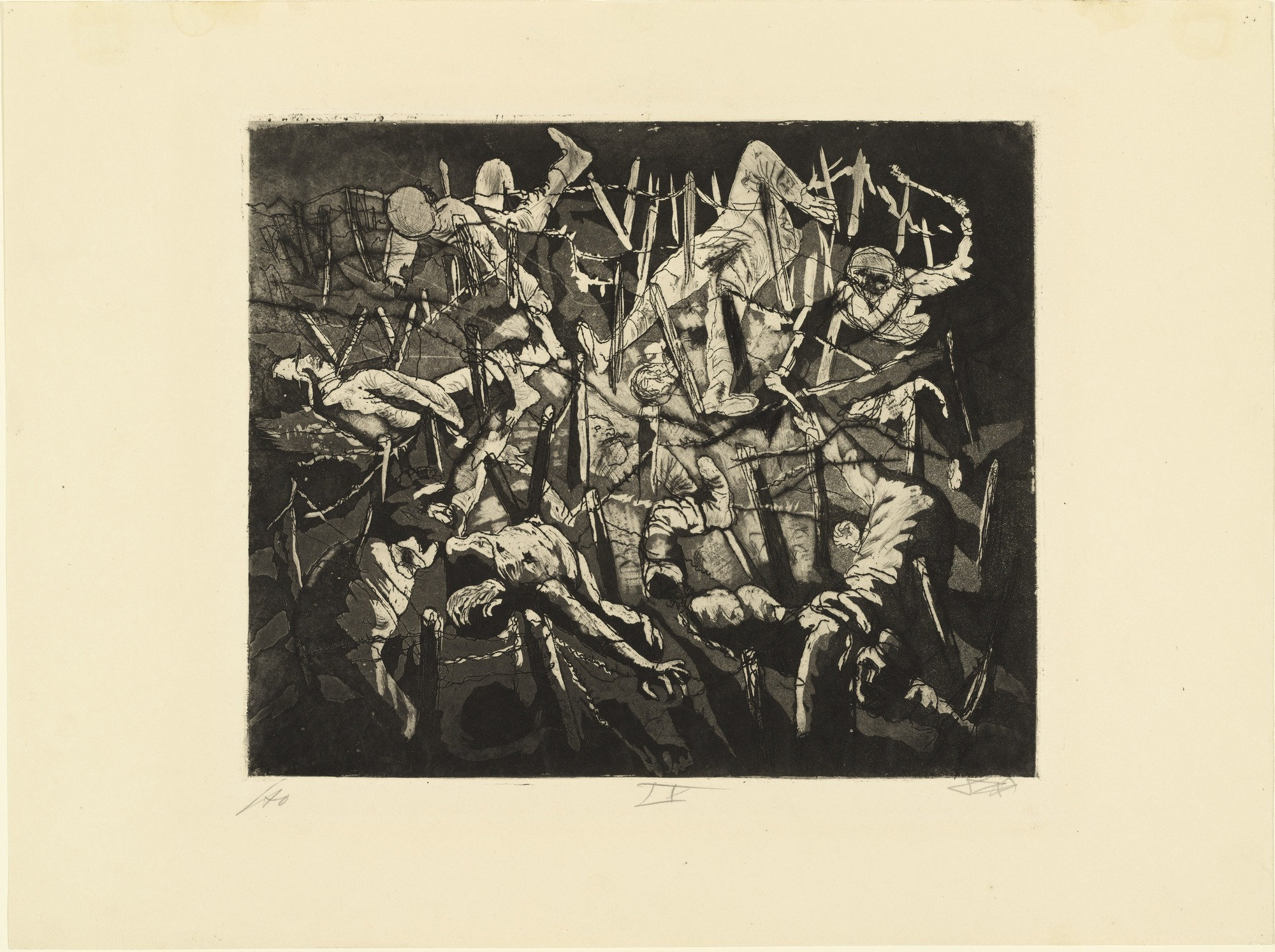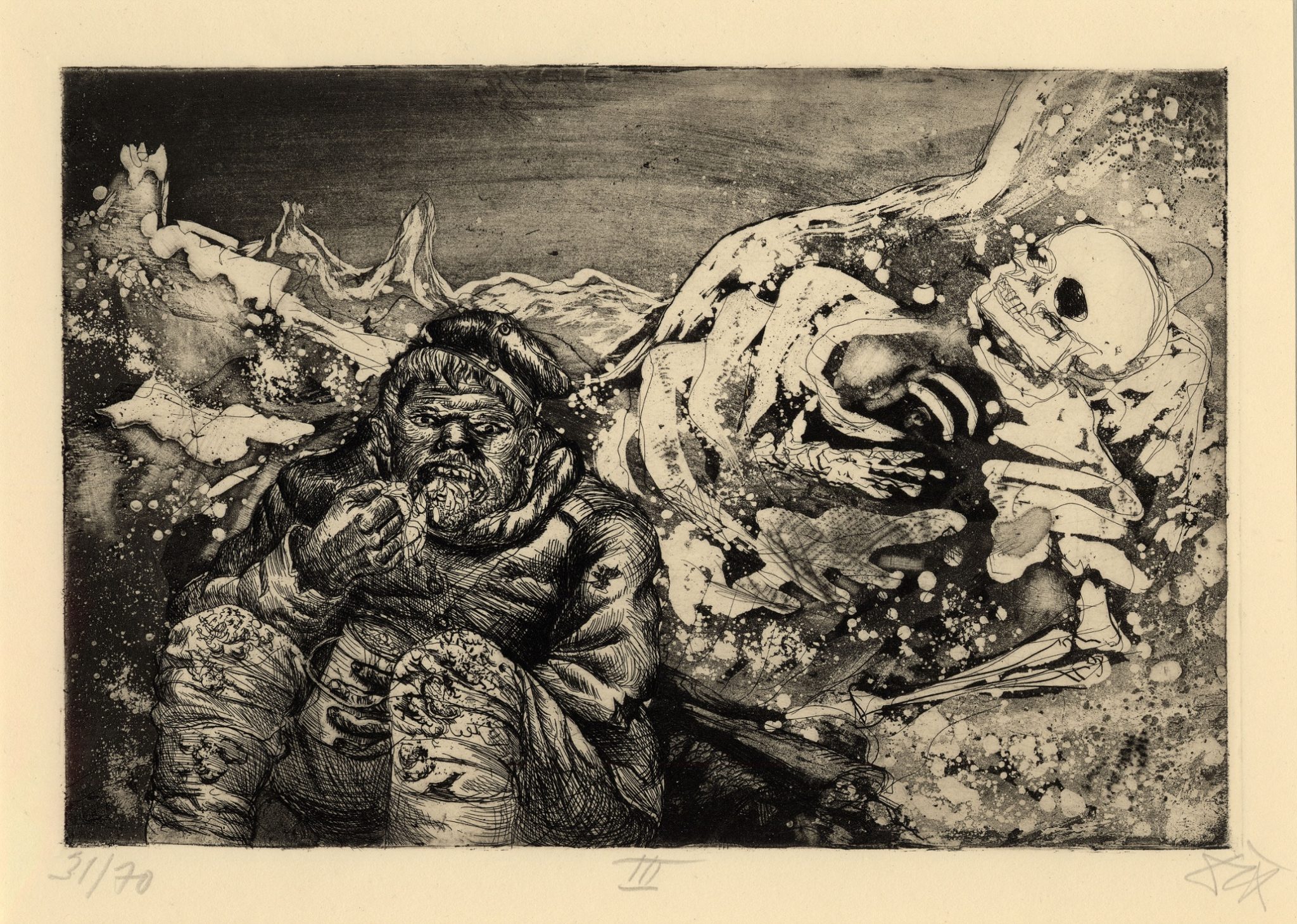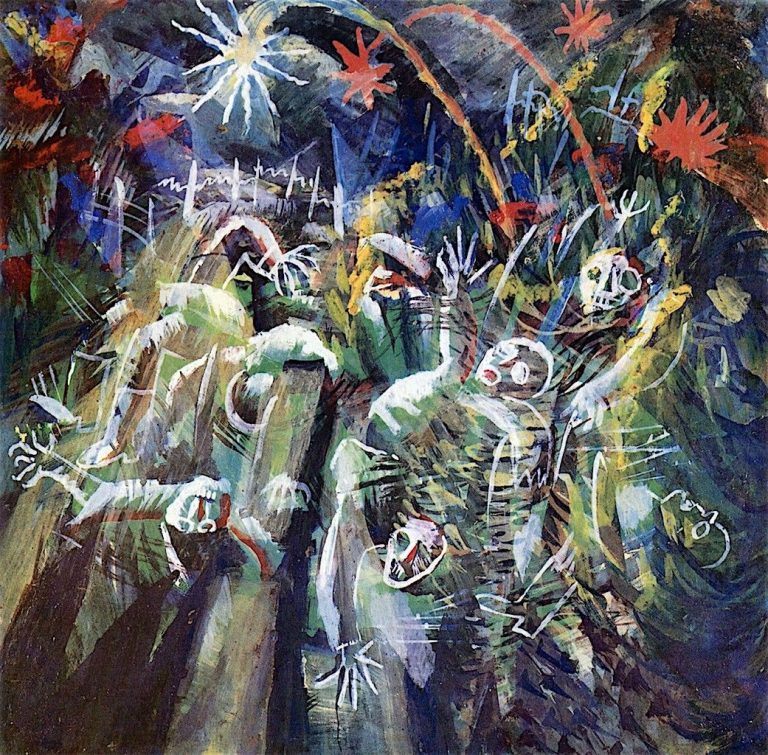
WWI Poster SCULL Otto Dix WW1 realism World War art print Dead soldier old paint eBay
Otto Dix. German, 1891-1969. Starr Figura, German Expressionism: The Graphic Impulse, New York, The Museum of Modern Art, 2011. Painter, printmaker, watercolorist. Known especially for his caustic portraits of postwar German society. Studied in Dresden from 1910 to 1914, where he encountered art of the Brücke and began painting in a colorful.

Otto Dix Danse de mort (1917)
Otto Dix - Scathing Satirist of German Brutalities. Otto Dix may have had more influence than just about any other German artist in molding public perceptions of the German Empire in the 1920s. Otto Dix's paintings are important components of the "New Objectivity" school, which also captivated Max Beckmann and George Grosz in the mid-1920s.

MoMA The Collection Otto Dix. Dance of Death 1917 (Dead Man Heights) [Totentanz anno 17
German artist Otto Dix was a committed painter of portraits. At a time when photography had diminished portraiture's importance and the genre was seen as a deeply unfashionable pursuit for so-called serious artists, he was making a living - and cementing his reputation - out of exactly that.

"The Triumph of Death, by Otto Dix" Sticker for Sale by ArautoCosmico Redbubble
Otto Dix and Max Beckmann were the principal German printmakers of the postwar period. Both were in the army although Beckmann withdrew after a breakdown in 1915. Dix, on returning to Dresden, made a series of expressive woodcuts, published by Heinar Schilling as Nine Woodcuts in 1922.

'The Trench', 1923, Otto Dix Ww1 art, Art, Art for art sake
Description of the artwork «Seven Deadly Sins» The picture "The Seven Deadly Sins" by Otto Dix was written in 1933, immediately after he was deprived of his teaching position at the Dresden Academy of Art and of any state content. Hitler came to power - and a wave of purges and new appointments swept through all the museums and art schools.

Experience The Diabolical Chaos of OTTO DIX CVLT Nation
Early Life. In December 1891 Otto Dix was born into the Generation of 1914. He was one of millions of late 19th Century babies who ushered in the 20th on the battlefields of the First World War. Dix was the eldest son of Franz and Louise. His father toiled in a iron foundry and his mother was a seamstress. Dix was exposed to art at an early age.
Flanders (Otto Dix, 1934) MLTSHP
Amah-Rose Abrams. Contributing Writer, London. Wilhelm Heinrich Otto Dix was an Expressionist master shaped by the experience of war, he lived and worked through and fought in WWI and WWII.

"The Triumph of Death, by Otto Dix" Canvas Print for Sale by ArautoCosmico Redbubble
Dead Soldier, plate five from Death and Resurrection, 1922 Otto Dix; Pimp and Whore, 1921 Otto Dix; Portrait of Mr. Bittermann, 1923 Otto Dix; North German Girl, c. 1920 Otto Dix; A Funeral, plate six from Death and Resurrection, 1922 Otto Dix; Night-time Encounter with a Madman, from War, 1924

Experience The Diabolical Chaos of OTTO DIX CVLT Nation
It took real courage for Otto Dix to paint Triumph of Death in 1934. A year after Hitler's rise to power, this artist who had depicted the first world war and Weimar decadence with stunning.

"The Triumph of Death, by Otto Dix" iPad Case & Skin by ArautoCosmico Redbubble
Born: December 2, 1891; Gera, Germany Died: July 25, 1969; Singen, Germany Nationality: German Art Movement: New Objectivity (Neue Sachlichkeit) Painting School: Dresden Secession, Degenerate art (exhibition, held by the Nazis in Munich in 1937, named to inflame public opinion against modernism) Field: painting, printmaking

Dance of Death 1917 (Dead Man's Hill). Museum PRIVATE COLLECTION. Author OTTO DIX Stock Photo
Otto Dix. Dance of Death 1917 (Dead Man Heights) (Totentanz anno 17 [Höhe Toter Mann]) from The War (Der Krieg). 1924 | MoMA Visit Otto Dix Dance of Death 1917 (Dead Man Heights) (Totentanz anno 17 [Höhe Toter Mann]) from The War (Der Krieg) 1924 Not on view

Otto Dix, Der Triumph des Todes. Flickr
Otto Dix Triumph of Death, 1934 In April 1933 the National Socialists dismissed Otto Dix from his teaching post at the Academy of Fine Arts in Dresden. The Triumph of Death appeared shortly thereafter and was no longer allowed to be exhibited.
Dance of death 1917 (Dead Man`s Hill) by Otto Dix (18911969, Germany) Museum Art
69 results Otto Dix Clear all Murder, plate two from Death and Resurrection, 1922 Otto Dix Evening on the Wijtschaete Plain (November 1917), from War, 1924 Otto Dix The Madam, 1925 Otto Dix Barricade Fighters, plate three from Death and Resurrection, 1922 Otto Dix Dead Soldier, plate five from Death and Resurrection, 1922 Otto Dix

Secret Lexicon Otto Dix The War
1924 Otto Dix (German, 1891-1969) published by Verlag Karl Nierendorf/Galerie Nierendorf (German) Status Currently Off View Department Prints and Drawings Artist Otto Dix Title Dance of Death, Anno Domini 17 (Dead Man's Hill), from War Place Germany (Artist's nationality:) Date 1924 Medium Etching, aquatint and drypoint on cream laid paper

The Crib Sheet Monthly Stumblings 6 Otto Dix
He saw the atrocities of World War I Prager street by Otto Dix, 1920, via the Otto Dix Organization In 1914, a then very patriotic 23 years old Dix, joined the military to defend his country in World War I. First, he joined as a volunteer, and he remained a machine gunner until the end of the war.

"The Triumph of Death, by Otto Dix" Sticker for Sale by ArautoCosmico Redbubble
Wilhelm Heinrich Otto Dix (German: [ˈvɪlhɛlm ˈhaɪnʁɪç ˈʔɔtoː ˈdɪks]; 2 December 1891 - 25 July 1969) was a German painter and printmaker, noted for his ruthless and harshly realistic depictions of German society during the Weimar Republic and the brutality of war. Along with George Grosz and Max Beckmann, he is widely considered one of the most important artists of the Neue.